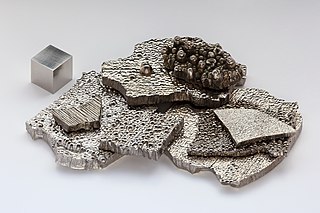
A veterinarian (vet) is a medical professional who practices veterinary medicine. They manage a wide range of health conditions and injuries in non-human animals. Along with this, veterinarians also play a role in animal reproduction, health management, conservation, husbandry and breeding and preventive medicine like nutrition, vaccination and parasitic control as well as biosecurity and zoonotic disease surveillance and prevention.

Group 9, by modern IUPAC numbering, is a group (column) of chemical elements in the d-block of the periodic table. Members of Group 9 include cobalt (Co), rhodium (Rh), iridium (Ir) and meitnerium (Mt). These elements are among the rarest of the transition metals.
Walter Plowright CMG FRS FRCVS was an English veterinary scientist who devoted his career to the eradication of the cattle plague rinderpest. Plowright received the 1999 World Food Prize for his development of tissue culture rinderpest vaccine (TCRV), the key element in the quest to eliminate rinderpest. Rinderpest became the first animal disease to be eliminated worldwide.

Avondale Agricultural Research Station or Avondale Discovery Farm is one of thirteen research farms and stations operated by Western Australia's Department of Agriculture and Food. In addition to its research, Avondale has historical buildings, a farming equipment museum and operates as an agriculture education centre specialising in introducing primary school children to farming, and teaching of its history in Western Australia.

Sydney Walter Josland was a New Zealand bacteriologist who specialised in research into Leptospirosis, Salmonella and the control of diseases in animals.

Hedley Ralph Marston FRS FAA was an Australian biochemist who worked for the Commonwealth Scientific and Industrial Research Organisation (CSIRO).

Motilal Madan is an Indian biotechnology researcher, veterinarian, academic and administrator. In a career spanning over 35 years, Madan published 432 research articles and policy papers in international and national reference journals—including 226 original research papers—and pioneered research in reproductive endocrinology, embryo biotechnology, In vitro fertilisation, and cloning.

Hugh McLeod Gordon, was a pioneering Australian veterinary scientist and parasitologist.
Eric John Underwood AO, CBE was an Australian scientist who pioneered research into sheep nutrition and wool production.

John Anderson Gilruth was a Scottish-Australian veterinary scientist and administrator. He is particularly noted for being Administrator of the Northern Territory from 1912 to 1918, when he was recalled after an angry mob demanded that he resign. This incident is known as the Darwin Rebellion.
The Faculty of Veterinary Science is a faculty of the University of Pretoria. Founded in 1920, it is the second oldest veterinary faculty in Africa. With the exception of the faculties in Khartoum, and Cairo, all the other African faculties were established after 1960. It is the only one of its kind in South Africa and is one of 33 veterinary faculties in Africa.

Cobalt is a chemical element; it has symbol Co and atomic number 27. As with nickel, cobalt is found in the Earth's crust only in a chemically combined form, save for small deposits found in alloys of natural meteoric iron. The free element, produced by reductive smelting, is a hard, lustrous, silvery metal.

Ira James Cunningham (1905–1971) was a New Zealand researcher in trace element nutrition and animal science. He is best remembered as a past president of the New Zealand Veterinary Association.
Cyril Spottiswoode Moy Hopkirk was a New Zealand animal science administrator and veterinary scientist. He was a world authority on bovine mastitis.

Robert Dudley Jolly is a New Zealand veterinary academic, currently an emeritus professor at Massey University, specialising in animal pathology. Much of his research has been into animal models of human disease, including Batten's Disease and mannosidosis.
Daria Nina Love was an Australian veterinary microbiologist and educator. She was the first woman to be awarded the University of Sydney Medal for Veterinary Science and the first woman in the Faculty of Veterinary Science to be awarded a PhD (1973), for her thesis entitled ‘Studies on virus host-cell relationships of a feline calicivirus’. She was also the first woman to become an associate professor in the Faculty of Veterinary Science, although her bids to become a full professor were unsuccessful. In 1988, she became the first woman in Australia to be awarded a Doctor of Veterinary Science on the basis of her work on the “Biological Properties of some Microorganisms of Veterinary Importance”. Love was renowned for the advances made through her research in the areas of soft tissue infections, oral cavity disease and feline and equine respiratory infections. She received a Rural Industries Research and Development Corporation (RIRDC) award for her outstanding contributions to equine research and the Australian Horse Industry in 2001.

Sir Thomas Dalling was a Scottish veterinarian and lifelong champion of veterinary research and education.

John McDougal Russell Greig CBE FRSE MRCVS was a Scottish veterinarian who was Director of the Moredun Research Institute from 1930 to 1954. He is noted for the development of several important animal vaccines: Enzootic abortion in ewes; Braxy and Louping ill. His work on milk effectively created "clean milk" for the first time in Britain.
Lt Col Harry Avery Reid OBE FRSE FRCVS was a 20th-century British military then government veterinarian, bacteriologist and pathologist who came to note as Director of Veterinary Services for New Zealand.

Cobalt is essential to the metabolism of all animals. It is a key constituent of cobalamin, also known as vitamin B12, the primary biological reservoir of cobalt as an ultratrace element. Bacteria in the stomachs of ruminant animals convert cobalt salts into vitamin B12, a compound which can only be produced by bacteria or archaea. A minimal presence of cobalt in soils therefore markedly improves the health of grazing animals, and an uptake of 0.20 mg/kg a day is recommended because they have no other source of vitamin B12.












